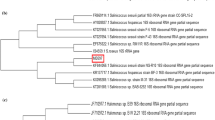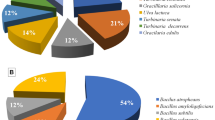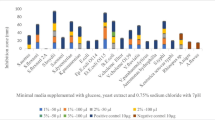Abstract
The present study was carried out with the aim to isolate an antibacterial pigment from seaweed-associated bacterium. The bacterium was identified as Halolactibacillus alkaliphilus MSRD1 by 16S rRNA sequencing. The isolated bacterium was cultured in 50 % Luria-Bertani seawater broth (LB-SWB) with 1 % glycerol. The pigment was extracted with 99 % ethanol and analyzed by UV-Vis spectroscopy at 490 nm. The candidate bacterium was optimized with various NaCl concentrations from 5 to 20 %. The results inferred that the bacterium produce maximum pigment at 5 % NaCl level. The candidate bacterium H. alkaliphilus MSRD1 was found to be producing the maximum pigment during the 120-h incubation. The protein content of the pigment was found to be maximum of 72 % at the end of the 120-h incubation. The extracted pigment was stable up to 80 °C, pink at acidic pH (1 to 5) and orange at basic pH (8 to 12). The isolated pigment was fractionated by silica gel column chromatography. Fractionated pigment was characterized by TLC, FT-IR, and SDS-PAGE. In the antibacterial context, the pigment was highly inhibited Staphylococcus aureus and Salmonella typhi with the zone of inhibition 16 and 14 mm, respectively. According to SDS-PAGE, the size of the pigment was approximately 80 kDa. The H. alkaliphilus MSRD1 has high capacity to produce the pigment with antibacterial properties. This could be effectively used in the future.






Similar content being viewed by others
References
August, P. R., Grossman, T. H., Minor, C., Draper, M. P., MacNeil, I. A., Pemberton, J. M., Call, K. M., Holt, D., & Osburne, M. S. (2000). Sequence analysis and functional characterization of the violacein biosynthetic pathway from Chromobacterium violaceum. JMMB, 2, 513–519.
Balint, Z., Lakatos, M., Ganea, C., Lanyi, J. K., & Varo, G. (2004). Nitrate transporting photochemical reaction cycle of the pharaonis halorhodopsin. Biophysical Journal, 86, 1655–1663.
Barja, J. L., Lemos, M. L., & Toranzo, E. A. (1989). Purification and characterization of an antibacterial substance produced by a parine Alteromonas species. Antimicrobial Agents and Chemotherapy, 33, 1674–1679.
Bradford, M. (1976). A rapid and sensitive method for the quantitation of microgram quantities of protein utilizing the principle of protein-dye binding. Analytical Biochemistry, 72, 243–254.
Calo, P., de Miguel, T., Sieiro, C., Velazquez, J. B., & Villa, T. G. (1995). Ketocarotenoids in halobacteria: 3-hydroxy echinenone and trans astaxanthin. Journal of Applied Bacterial, 79, 282–285.
Fenical, W. (1993). Chemical studies of marine bacteria: developing a new resource. Chemical Reviews, 93(5), 1673–1683.
Gibson, J., Sood, A., & Hogan, D. A. (2009). Pseudomonas aeruginosa-Candida albicans 89 interactions: localization and fungal toxicity of a phenazine derivative. Applied and Environmental Microbiology, 75(2), 504–513.
Holmstrom, C., Egan, S., Franks, A., McCloy, S., & Kjelleberg, S. (2002). Antifouling activities expressed by marine surface associated Pseudoalteromonas species. Federation of European Materials Societies Microbiology Ecology, 41(1), 47–58.
Khanafari, A., Khavarinejad, D., & Mashinchian, A. (2010). Solar salt lake as natural environmental source for extraction halophilic pigments. Iranian Journal Microbiology, 2(2), 103–109.
Konzen, M., Marco, D. D., Cordova, C. A. S., Vieira, T. O., & Antonio, R. V. (2006). Creczynski-Pasa TB antioxidant properties of violacein: possible relation on its biological function. Journal of Bioorganic Medicinal Chemistry, 14, 8307–8313.
Laemmli, U. K. (1970). Cleavage of structural proteins during the assembly of the head of bacteriophage T4. Nature, 227, 680–685.
Lee, J. H., Kim, Y. S., Choi, T. J., Lee, W. J., & Kim, Y. T. (2004). Paracoccus haeundaensis sp. nov., a Gram-negative, halophilic, astaxanthin-producing bacterium. International Journal of Systematic and Evolutionary Microbiology, 54(5), 1699–1702.
Misawa, N., Satomi, Y., & Kondo, K. (1995). Structure and functional analysis of a marine bacterial carotenoid biosynthesis gene cluster and astaxanthin biosynthetic pathway proposed at the gene level. Journal of Bacteriology, 177(22), 6575–6584.
Pierson, L. S., & Pierson, E. A. (2010). Metabolism and function of phenazines in bacteria: impact on the behavior of bacteria in the environment and biotechnological process. Applied Microbiology and Biotechnology, 86(6), 1659–1670.
Pusecker, K., Laatsch, H., Helmke, E., & Weyland, H. (1997). Dihydrophencomycin methyl ester, a new phenazine derivative from a marine streptomycete. Journal of Antibiotics, 50(6), 479–483.
Rainey, F. A., Ward-Rainey, N., Kroppenstedt, R. M., & Stackebrandt, E. (1996). The genus Nocardiopsis represents a phylogenetically coherent taxon and a distinct actinomycete lineage; proposal of Nocardiopsaceae fam. nov. International Journal of Systematic Bacteriology, 46, 1088–1092.
Rausch, T. (1981). The estimation of micro-algal protein content and its meaning to the evaluation of algal biomass I. Hidrobiologia, 78, 237–251.
Rustom, S. M., Valiollah, H., Alka, M. P., & Prafulla, J. D. (1990). Isolation and characterization of Serratia marcescens mutants defective in prodigiosin biosynthesis. Current Microbiology, 20(2), 95–103.
Ryazantseva, I. N., Saakov, V. S., Andreyeva, I. N., Ogorodnikova, T. I., & Zuev, Y. F. (2012). Response of pigmented Serratia marcescens to the illumination. Journal of Photochemistry and Photobiology B: Biology, 106, 18–23.
Saitou, N., & Nei, M. (1997). The neighbor-joining method: a new method for reconstructing phylogenetic trees. Molecular Biology and Evolution, 4, 406–425.
Song, C., Makoto, S., Osamu, J., Shinji, O., Yasunori, N., & Akihiro, Y. (2000). High production of prodigiosin by Serratia marcescens grown on ethanol. Biotechnology Letters, 22(22), 1761–1765.
Tan, M. W., Mahajan-Miklos, S., & Ausubel, F. M. (1999). Killing of Caenorhabditis elegans by Pseudomonas aeruginosa used to model mammalian bacterial pathogenesis. Proceedings of the National Academy of Sciences of the United States of America, 96(2), 715–720.
Thompson, J. D., Gibson, T. J., Plewniak, F., Jeanmougin, F., & Higgins, D. G. (1987). The ClustalX windows interface flexible strategies for multiple sequence alignment aided by quality analysis tools. Nucleic Acid Research, 24, 4876–4882.
Turner, J. M., & Messenger, A. J. (1986). Occurrence, biochemistry and physiology of phenazine pigment production. Advances in Microbial Physiology, 27, 211–275.
Acknowledgments
The authors gratefully thank C. Parthiban (Project Scientist, NCSCM) for the identification of seaweeds and preparation of the manuscript.
Conflict of Interest
We declare that we have no conflict of interest.
Author information
Authors and Affiliations
Corresponding author
Additional information
Suresh holds a Ph.D degree, Annamalai University
Renugadevi holds a M.Sc degree, A.V.C.College (Autonomous)
Brammavidhya holds a Ph.D degree, A.V.C.College (Autonomous)
Iyapparaj holds a Ph.D degree, Annamalai University
Anantharaman holds a Ph.D degree, Annamalai University
Rights and permissions
About this article
Cite this article
Suresh, M., Renugadevi, B., Brammavidhya, S. et al. Antibacterial Activity of Red Pigment Produced by Halolactibacillus alkaliphilus MSRD1—an Isolate from Seaweed. Appl Biochem Biotechnol 176, 185–195 (2015). https://doi.org/10.1007/s12010-015-1566-6
Received:
Accepted:
Published:
Issue Date:
DOI: https://doi.org/10.1007/s12010-015-1566-6




